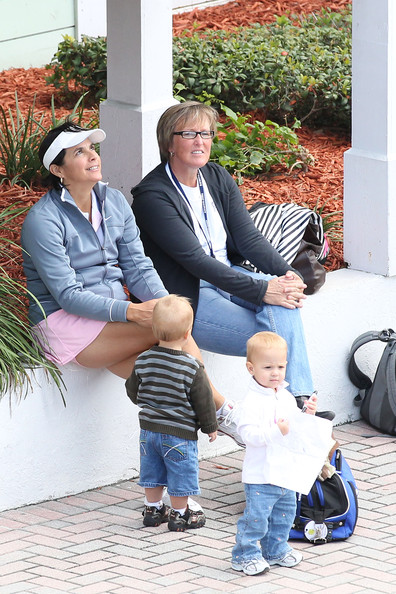by Mindy Fried | Sep 14, 2010 | family, parenting, policy, value of caregiving work, women and work
Like many daughters and sons, I am a caregiver from afar, talking to my father on a daily basis, sometimes two to three times a day, consulting with nurses and doctors, and managing a cavalcade of dedicated caregivers who do “my” job by proxy. I supervise the caregivers, support them and problem solve with them. They are my eyes and ears and I am ever grateful for their insights. I’m very lucky to share this job with my sister, who takes on a lion’s share of caregiving work, and with whom I can laugh, grumble and cry when needed. We are far from alone as distance caregivers…
The elderly population in the U.S. is expected to more than double between now and 2050, according to Boston College’s Center for Work & Family. Thousands of adult children take care of their parents. Not surprisingly, given the gender division of labor in families, about two thirds of these caregivers are daughters. On average we are about 50 years old, and the recipients of our care are on average about 77 years old. My father is a lot older than that. In fact he’s almost 100! I truly hope I inherited his cat-has-nine-lives genes, but we shall see…
Of all the adults who care for an elder parent, a little over 10% do it like us, from afar. My sister and I tried to get our dad to come live in either of our cities, but he is rooted in his own hometown. It is there that he has established his identity and is surrounded by a flock of loved ones, including people who admire him for his past accomplishments.
There’s no doubt that caring for an elder parent requires a team effort. It’s hard to imagine how some people do it, or sometimes even how we do it! The older our father gets, the more we have hunkered down to the task of trying to keep him healthy and engaged, and to help him remember who he is and has been in his life. And yet ultimately, there is a limit to how much power or influence we – his loved ones, friends and paid caregivers – actually have.
Nearly 60% of those who care for their elder parents are in the paid workforce, and the majority of us work full-time. Our work as caregivers is on top of – and sometimes in the midst of – our paid work. It’s not uncommon for me to get a call in the middle of my workday either from my father or about my father, and whatever work is generated from the call simply gets woven into the many strands of my other responsibilities. I’m lucky that as a consultant who makes her own hours — working odd times and places — I have the workplace flexibility that allows this weaving process.

An increasing number of employees need flexibility in their paid work schedules to accommodate the responsibilities they have as unpaid caregivers. They may need to drive elder parents to appointments, and those of us who provide care from a distance may need to find other people to do the driving. Whether near or far, we often make those appointments, monitor medications, buy necessities, ensure that their housing is safe, their meals nutritious, and their friends aware of what’s going on. We often need to fight to ensure that the care of our parents is high-quality and consistent. More than 54% of caregivers have advocated for their “care recipient” with providers of services and government agencies, according to the National Alliance of Caregiving.
In a report by the Center for Boston College Center for Work & Family, researchers say:
“It is surprising that employers are not moving faster to address elder care issues in the workplace. Why? Many employers just don’t know what to do, or have difficulty grasping the extent to which elder care is an issue for their employees.”
Researchers found that workers often opt not to discuss their caregiving problems with coworkers or supervisors, “a silence reinforced by our society’s reluctance to confront issues of aging and death.”
They also note that the business impact of not responding to employees’ caregiving responsibilities is significant, and includes work interruptions (e.g, unexpected time off, tardiness) which may affect worker productivity; caregiver stress and fatigue that can result in higher medical and employee assistance costs; and potential turnover when employees simply cannot balance caregiving and work demands. In fact, according to a 1995 study by Metropolitan Life Insurance Company, elder care costs a company about $3,142 a year per employee, based on various costs associated with employee productivity.
In a 2009 study by the Sloan Center on Aging & Work at Boston College, researchers found,
“Over 78% of respondents reported (that) having access to flexible work options contributes to their success as employees to a moderate or greater extent (and) 90% reported that (these) options contribute to their overall quality of life to a moderate or great extent.”
Flextime, compressed work hours and telecommuting are just some of the alternative scheduling options that can help workers with their caregiving demands. While there are some “family-friendly” companies that recognize the personal needs of their workforce, there’s still a long way to go. In a study I did on flexible work policies in five large corporations, I found that unless companies had a written work policy that all employees were aware of, employees found it difficult to negotiate an arrangement with their supervisors.
Interestingly, according to the National alliance for Caregiving, from 2004 to 2009, there has been a notable increase in the percentage of caregivers who live within 20 minutes from their elder parents – from 44% to 51%. Regardless of where we live, our elder parents need us. And as caregivers, we need support — from our family and our workplaces — to be there for them.
Finally what can government do? Right now we have an inadequate law – the Family and Medical Leave Act – that provides unpaid leave to employees who take time off from work to care for a sick family member. Making that policy a paid leave would be a good start…
by Mindy Fried | Aug 30, 2010 | child care, parenting, value of caregiving work, women and work
I have to admit that I’m a sap for human interest stories in the news. And lately, this dominates what we are fed by the media. I’m even a sucker for the obituaries, which can provide fascinating portraits of people’s lives. The story that grabbed me this morning was the one about former tennis champ, Gigi Fernandez, and her quest to have children (http://tiny.cc/hak4h). Never mind that I’d never heard of her (apologies to any Gigi fans!).
With a title like “A Dream Deferred: Almost Too Long”, I was hooked. Spring forward (to the middle of the story) where she and her female partner now have toddler twins, thanks to a friend who donated eggs and an anonymous sperm donor. (By the way, kudos to the New York Times for not making a big deal that they are a same-sex couple.) When Gigi’s friend asked her, “What do you need to have a baby?”, she replied “eggs”. Love that line. Wish some of my friends would ask me what I need to get exactly what I want, and then say, no problem, I have some and you can have them. (I could use a new car, for anyone who is reading this.)
Gigi struggled to get pregnant. She was over 35, which believe it or not puts a woman in the “high risk” category. I know this from personal experience, even though I did not encounter the same problems as Gigi. In addition to her age, according to her doctor, Gigi’s “Hall of Fame career” contributed to her inability to conceive. After seven infertility treatments, her doctor told her that her eggs were old. Ewww… Now there’s an image – and it must have stung. Like many athletes, GiGi’s career was dependent on her physical strength and agility, and her body let her down. She is quoted in the article as saying, “As an athlete, you have this attitude. I can do anything with my body… That’s how you think. So your biological clock is ticking, but you’re in denial.”
Gigi soaked up our society’s cultural imperative about the value of motherhood, as reflected in her insightful comment: “There is this implication that women are here to bear children, and if you can’t bear children, you’re useless.” Actually, 18% of US women in the U.S. do not have children, a figure that is gradually rising.
In Europe, it appears that the percentages of women who do not have children are higher. In Germany and Austria, one third of women in their 40s do not have children.
Meanwhile, Gigi persevered and got what she wanted: healthy twins. She says that after a career of being very selfish, she is now selfless. One might conclude that this means she no longer works for pay. But in fact, she has figured out a way to balance the care of her twins with her work teaching tennis and running a business. Of course, she has the advantage of financial success that makes a lot of this possible.
According to U.S. Census data, there are at least 270,000 children being raised by same-sex couples. But this does not include single LGB parents or transgender parents, and it is likely that same-sex parents are under-reported by the Census.
I’m glad that of all the puff pieces I see in the news, the New York Times chose to write about a lesbian in a same-sex relationship who opened herself to an alternative form of creating a family, and succeeded.
by Mindy Fried | Jul 24, 2010 | child care, early education and care, parenting, value of caregiving work, women and work
My daughter is “launched”, having successfully completed her first year of college. A kid who never liked to leave home for more than an overnight with a friend, she welcomed change with curiosity, an open mind and excitement. The year went well for her on all fronts, as she plunged into new friendships and new academic challenges in a culturally vibrant city. What else could a mom want? Happy kid, happy mom…
We have always been close, but we are becoming friends of a different sort now. At the same time, as her mother, I still feel a sense of responsibility and protectiveness towards her. How to balance these roles cannot be premeditated and planned. The balance strikes me emotionally, as it teeters back and forth depending on context and circumstance.
This summer, our daughter decided to become an au pair in the UK, where we have family. I admired her ability to take charge and find a job in a country where she has never lived, and yet has citizenship. Refusing most of my offers of help, she planned her journey, found the host family, and ultimately took on the responsibility of caring for 3 young children, ages 4 and under for 6 weeks. Yikes! Just the sheer number of children would drive me crazy! But shortly after she arrived, adding additional stress to this scenario, the family dynamics went very sour and she gradually realized that she had to get out. My husband and I had planned a visit in the middle of her stay, and as the time drew nearer, we realized that the purpose of our visit was to help her extract herself from the situation.
The job of an au pair is well-defined in many countries, but my guess is that the majority of au pairs operate outside of any regulations. According to the British Au Pair Agencies Association:
“The au pair programme is an internationally recognised Cultural Exchange Programme. It offers a young individual the opportunity to travel and live/work with a host family in a new country, learn a foreign language and experience the country’s culture. The au pair will work a set amount of hours for the host family, usually doing a mixture of childcare and light housework. The au pair may have some childcare experience, but an au pair is not a nanny and should also not be treated as a housekeeper.”
In our daughter’s situation, the work hours grew to 12 per day, and the children came to rely on her nearly exclusively for their most basic needs as well as constant love and attention. As tension between the parents grew, their dependency on her grew as well
In her study of what she calls the “shadow work of nannies and au pairs,” sociologist Cameron MacDonald says,
“Contemporary working mothers and child care providers are actively involved in a process of redefining motherhood. The nexus of this redefinition involves the negotiation of child-rearing practices, of who does what and what that division means.”
In our daughter’s host family, the mother wanted an egalitarian marriage and the father felt that it was his wife’s “duty” to be primary caregiver. They both seethed with resentment. Sociologist Arlie Hochschild says this phenomenon is the result of a stalled gender revolution, in which women are changing and men haven’t yet caught up with them. The “mum” in the host family rebelled against her husband’s views by going out partying with single friends at high class clubs (there’s a class element here as well, of course!), and the dad rebelled by working long hours, going to the pub with his mates, and indulging in his obsession with watching car racing and playing golf. Meanwhile, the children were neglected by their parents, who preferred spending money on their vocations instead of their children. Consequently, the children were emotionally needy.

The parents were high earners, but when it came to paying our daughter, they were stingy, nickel and diming her for cash she fronted for their children, and at times questioning the number of hours she worked for them. Since they were avoiding each other, there were times they didn’t seem to know that she was the one caring for their children. And yet each of them confided in her about their marriage. Of course, it is their children who suffer the most, and as their caregiver, our daughter wanted to protect them. At the same time, she had to protect herself.
She learned that it is difficult to leave a job, particularly one in which young children are involved. She was lucky because she speaks the language, has family nearby and parents who were there to support her. But this is often not the case for au pairs… and therefore they may be vulnerable to exploitation. Au pairs become part of the family dynamic, which in a good situation can be very fulfilling, but in a negative situation, can be emotionally wrenching, as the child caregiver becomes closer to the children. It was hard for our daughter to leave, but ultimately she knew that it was time to go, and we helped her do it. Not an easy situation, by any means.

As a visitor to this host family’s home, I was infuriated at how the family was taking advantage of her, but also awed by the amazing job our daughter did, providing love and security to the children and standing up for herself in the toughest of situations. To be honest, it also felt good being “mommy” again. And there is my challenge – finding the balance between a growing friendship with my young adult child and still maintaining the protective role of mother. Supporting her to walk away without telling her to do so…











